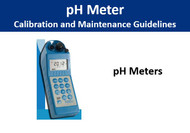pH Meter Calibration and Maintenance Guidelines
Posted by David Cannon on 30th Nov 2020

When discussing the quality of water, pH measurement plays an important role. A pH meter is extremely efficient and provides accurate results about the nature of water in terms of alkalinity or acidity. The pH electrodes are the main component of a pH meter. The glass and reference electrodes are housed inside a thin glass membrane. A pH meter determines the pH level by measuring the potential difference between the two. As the chemistry of pH electrodes is susceptible to change, pH meter calibration becomes an important step. Regularly calibrating a pH meter will only increase the reading accuracy and operating efficiency in spite of repeated measurements. This post highlights the best practices that help calibrate accurately and extend the life of the meter.
3 Easy-To-Follow Guidelines for pH Meter Calibration and Maintenance
The following practices help you calibrate and extend the life of a pH meter.
- Calibrate pH Meter Frequently: With ageing and continuous use, the performance of the electrode will stray and provide offset values over time. To get an accurate measurement, it's important to identify the changes to the electrode's properties. This is also known as an offset error. Microprocessors of pH meters perform multi-point calibration, where the real slope of the electrode compares to its intended slope. This determines the offset error. Using the real slope and offset error, the processor will regulate the measurements to compensate electrode changes. This helps calibrate your pH meter precisely.
- Clean, Store and Recondition Electrodes Properly: Generally, electrodes are designed to connect pH meter through a BNC connector or cable. Regardless of the type of electrodes, one must store electrodes in storage solution instead of keeping them in deionized water. The storage solution comprises a mix of chemicals preventing the growth of bacteria. This helps prolong the electrode's life. The buffer 4 solution is the most widely used storage solution for pH electrodes. Also, it is important to rinse the electrode after each use rather than wiping it with a cloth. Importantly, different pH meters require different care. Thus, don't forget to refer to the product guidelines and manuals to get optimal results.
- Submerge Electrodes While Taking Readings: The accuracy of your pH meter highly relies on the use of the electrode. While taking a pH reading, ensure the glass bulb of the electrode and the junction of the reference electrode are submerged properly inside the solution. Since the glass bulb is the primary source of interaction, ensure it is exposed to the substance that will improve the accuracy of readings as well as the response time of the pH meter. To understand how far to submerge a pH meter, one must know the place where the electrode bulb is located and how it needs to be submerged to cover the junction
Having understood the importance of pH meters, it is also important to source them from trusted industry leaders. Today, you will get these devices from many brands; however, not all would meet your requirements. This is where one should approach an expert like Cannon Water Technologies. With a vast experience, the company provides pH meters from several industry-leading brands. The highly skilled and experienced experts will help you choose the appropriate pH meter according to the requirements of your application.
